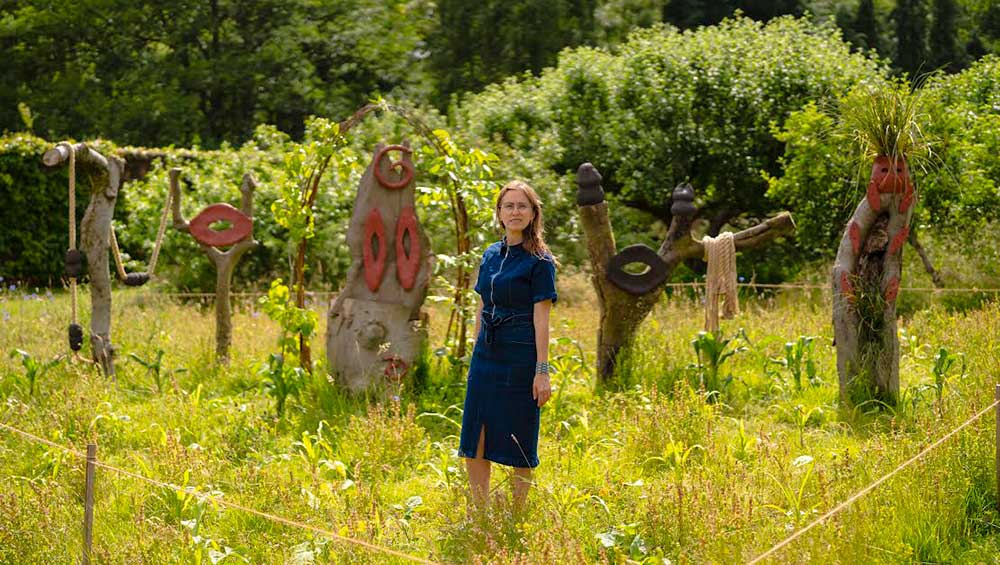
Lucia Pizzani, Cultivo y Memoria (Crop and Memory), Harewood Biennial 2024 Create/Elevate. Photo: Drew Forsyth, courtesy Harewood House Trust.
by SABINE CASPARIE
Lucía Pizzani moved to London from Venezuela in 2007, but the influence of South America remains present in all her works. In her exhibition at Bosse & Baum last year, she honoured ancestral spiritual practices by converting the gallery space into a temple to Meruntö, a cosmic energy force derived from the sun that South American Pemon Indigenous tradition holds to be housed in all living organisms. Also last year, at Fulmer Sculpture Park, she did performance around her ceramic sculptures on the day of the Solstice, using Venezuelan songs related to the sun. She uses clay and live plants as her main media – works that hold in their material makeup interspecies stories of migration.
The cross-fertilisation in her work is not limited to countries and cultures. Having studied conservation biology in Venezuela and been involved with an environmental NGO there for many years, Pizzani strongly believes in the connectedness of all living things: plants, animal and human. A quote from Edward O Wilson’s 1984 Biophilia accompanied her exhibition with Vanessa da Silva at Sapling in 2022. “Humanity is exalted not because we are so far above other living creatures, but because knowing them well elevates the very concept of life.” Pizzani’s gallery, Cecilia Brunson, wrote of her ability to use “visible routes as gateways for invisible ones”.
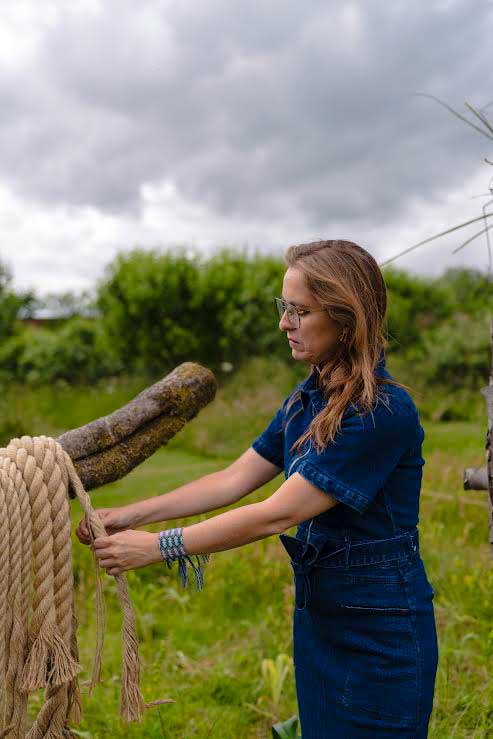
Lucia Pizzani, Cultivo y Memoria (Crop and Memory), Harewood Biennial 2024 Create/Elevate. Photo: Drew Forsyth, courtesy Harewood House Trust.
In 2021 the Tate Gallery acquired two of Pizzani’s works from 2013: Textiles, which consists of four human-scale cocoons in Dutch wax fabric, stemming from a performance in Lanzarote,and Impronta, a series of photographs featuring those cocoons but inhabited by women and done using the collodion wet-plate process, a technique favoured by the Victorians. Both were part of The Worshipper of the Image, a project Pizzani did after receiving the Premio Eugenio Mendoza in Caracas in 2013. “The workshave a lot of the elements that I use in my practice,” she told me. “First of all, the idea of transformation in the natural world: the cocoons relate to the idea of becoming, of metamorphosis. They also talk specifically about women and inequality, the cocoons a metaphor for women being trapped. Then there’s the idea of the body: the outer layer, the membrane, the second skin. Plus, the textile itself is Dutch wax print: a technique that comes from Indonesia, but was related to trade and colonial routes and which I found in Brixton where I have lived for 15 years, a very multicultural community that mirrors my own condition of migrant.”
This year, Pizzani is included in the third Harewood Biennial with an installation of live plants, ceramic sculptures and arboreal fragments in Harewood House’s walled garden titled Cultivo y Memoria (Crop and Memory), and showing at Cecilia Brunson Gallery in the exhibition Rites, Seeds and Refuge. Currently in Venezuela for a much-needed holiday, she doesn’t sit still even there: she has just opened her exhibition Morada Vegetal at Abra, her Caracas gallery, and is planning to do two weeks of research on Margarita Island for her upcoming inclusion in the curated section Smoke at Frieze London this October, curated by Pablo José Ramírez.
Studio International spoke to Pizzani over Zoom.
Sabine Casparie: You are speaking to me from Venezuela. How is it being back in your home country?
Lucía Pizzani: Let me show you the view from here: the mountains in the background. They separate the valley from the Caribbean sea. And there’s the city.
Every time I come here, I am overwhelmed by nature. As soon as you arrive, you start seeing all kinds of animals: macaws, insects, everything. Every night, you have these frog sounds. It’s so green here and I’m trying to connect with this energy of life. There’s a real richness – in nature, in the spirits of people, who are very resilient. As for the political situation, there will be elections next week, so there is a lot of uncertainty. I’m about to open an exhibition in an artists’-run space here. It’s called Morada Vegetal which means vegetal home. I am trying to create a safe space, a refuge in the current climate.
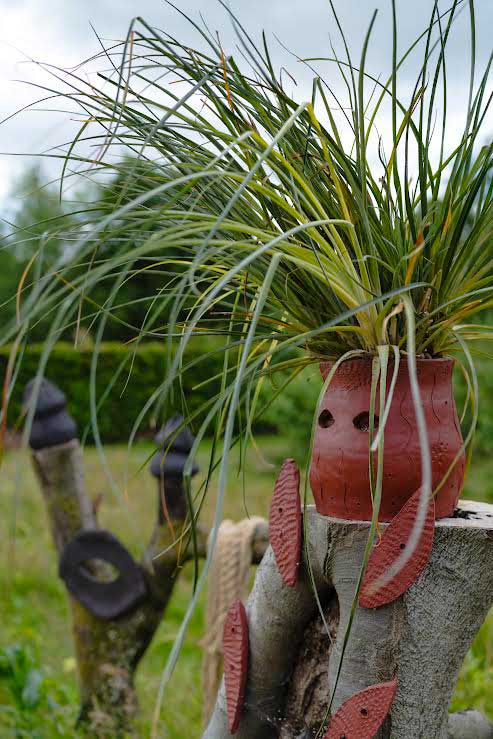
Lucia Pizzani, Cultivo y Memoria (Crop and Memory), Harewood Biennial 2024 Create/Elevate. Photo: Drew Forsyth, courtesy Harewood House Trust.
SC: Your latest project in the UK is a commission of five sculptures as part of the third Harewood Biennial Create/Elevate, which has as its theme the use of craft for cross-generational knowledge sharing. Can you tell me a bit more about your involvement?
LP: The organisers invited me to make work for the walled garden after seeing some of my projects in botanical gardens, like the one I did during a residency in Mexico at Casa Wabi in 2021, and my exhibition last year at Bosse & Baum, where I showed sculptures and ceramics with plants. Harewood House’s kitchen garden has been in use since 1771 and it has so much history: it was the source of food for the people in the palace and the workers. When we started digging holes to put the sculptures we found remains of terracotta pots.
There are three elements to my installation: pieces of fallen trees, my ceramic sculptures and live plants. For the planting, I chose to use the method called “three sisters”, a very ancient method from Meso-American cultures where corn, bean and squash are planted together, supporting each other by providing nutrients. It’s a cooperative way of sowing, but at the same time it’s also a perfect diet for humans: carbohydrates, vitamins and proteins. The installation is an evolving, alive type of work. We hope to harvest the crops in the autumn, and they can be used in the cafe. That has been the story of this place for a long time. I like this idea that the health of the ecosystem can be the health of the humans.
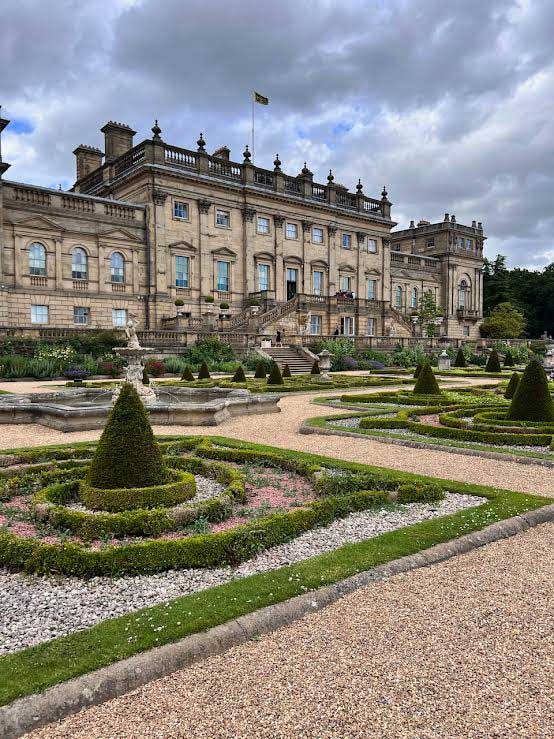
Lucia Pizzani, Cultivo y Memoria (Crop and Memory), Harewood Biennial 2024 Create/Elevate. Photo: Drew Forsyth, courtesy Harewood House Trust.
SC: How was it to work with Trevor Nicholson, head gardener at Harewood House?
LP: Trevor was very knowledgeable, showing me trees and plants that we could use. It was a beautiful exchange. I think he is very artistic, and he really appreciates the vegetation, not just in a practical way – you can see it in the photographs he takes. I think there are many ways to be artistic.
SC: You also have an exhibition at Cecilia Brunson Projects, in which you combine the materials of clay and live plants. There are these sculptural totems made from English clay imprinted with plants such as corn and eucalyptus. What do you like about clay as a material?
LP: When I started working with clay about 15 years ago, it made so much sense. In Venezuela, I worked with environmental organisations and studied conservation biology, so I wanted to use organic materials. Clay is also related to ideas of soil and territory. I have used clay from different places – France, Venezuela, Mexico, the UK – and each has a different colour, a different texture. Every place I go, I embrace the specificity of each soil. I also like that clay is malleable and tactile and contains ideas of the skin, the body and touch. For my degree at Chelsea College, I was imprinting my own body on the plaster mounted on the wall; now, I am imprinting corn on clay.
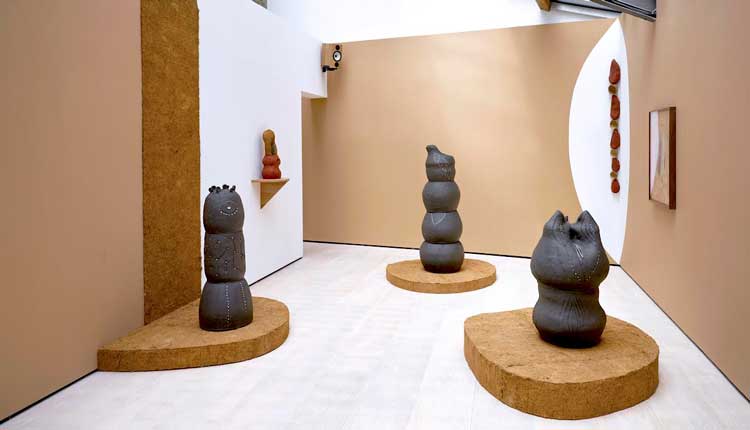
Lucia Pizzani, Flora Totems, 2023. Black stoneware clay and slip. Photo: Andy Keate, courtesy of Cecilia Brunson Projects.
SC: Another series of works at Cecilia Brunson Projects includes your photo-collages on amate paper. They show animal skin, often snakeskin. What is it about skin that you find so fascinating?
LP: It’s this idea of protection. I come from a place that has been in a crisis for so many years. Almost all my family members have experienced some form of violence: kidnaps, robberies, my dad has been shot at. So, we all felt the threat as immediate and in our bodies. I was thinking about how to create an armour made with animal skins, using thick ones like the pangolin, animals that have spikes. But it’s not only about protection, it’s also about healing, the idea of a second skin. The snake sheds skin and grows a new one and humans also do – our skin becomes part of the air in the form of dust. So, I also think about what happens after the moment of crisis: the possibility of healing.
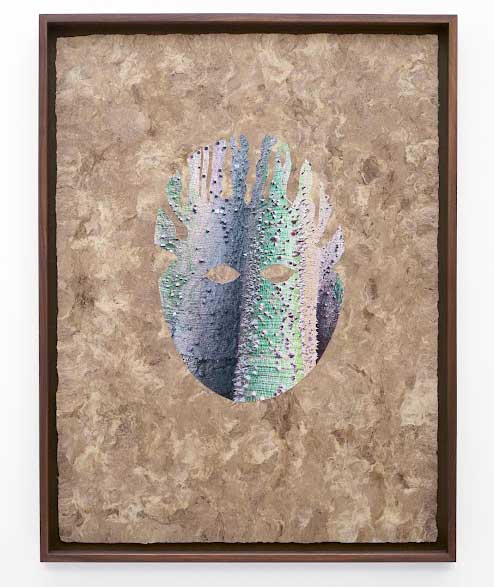
Lucia Pizzani, Ceiba Deity, 2024. Photographic collage on Amate paper. Photo: Andy Keate, courtesy of Cecilia Brunson Projects.
SC: You have made the space at Cecilia Brunson Projects into a total environment: using coconut fibres for the plinths, painting the walls, a soundscape produced by Ezequiel Pizzani that incorporates the wind and sounds of hummingbirds and bees. When I visited, there were insects flying around the gallery. It invoked in me the feeling of entering a sacred site. Is that what you were going for?
LP: I wanted to create a space where you feel calm, a space of tranquillity. There’s this idea that we were once one with nature. But that unity broke. So, I’m always trying to do things that reconnect us with nature. A lot of cultures still have the belief that everything that is alive has a soul. It’s a reverence to the spirit of plants, to the spirit of nature. Many of my works have eyes, which is my way to humanise vegetal matter. As soon as you have something looking at you, it’s asking you to look back. “Come on, look at me, I’m here. We both are. We are beings and we are alive.”
SC: It’s really beautiful. I am wondering if this way of thinking of older civilisations is still more present in the southern hemisphere than here in the UK?
LP: I think for some people it’s a choice; you can be living in a city and choose to believe that. For other people, it’s part of their culture. In Venezuela, I have worked with many Indigenous communities: the Yekuanas, the Piaroas and the Pemon. One of the first projects I participated in through my environmental activities was in La Esmeralda. I just reconnected with Temeni, a Yekuana friend, who is now on Facebook. Imagine! They have many problems: mainly mining and the deforestation and poisoning of the bodies of water that it brings, but at the same time they are redoing the ancestral “churuata”, the communal home. It has a huge circular roof made of palms. The whole community is building this, building a home, it’s sacred. I like this idea of the home: the planet is our home, our community is our home.
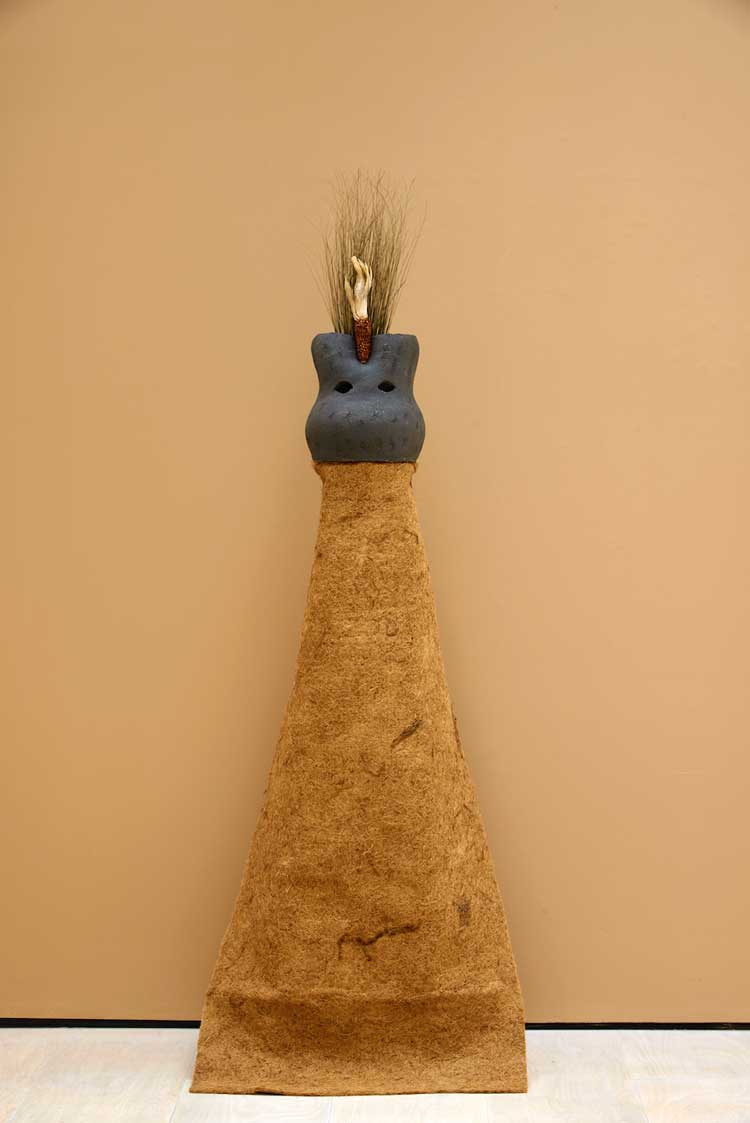
Lucia Pizzani, Ser de Maíz, 2024. Black stoneware clay, coconut fibre, dried treated corn cob and dried treated palm stems, 176 x 70 x 70 cm (69 1/4 x 27 1/2 x 27 1/2 in). Photo: Andy Keate, courtesy of Cecilia Brunson Projects.
SC: You seem to have replaced your previous work in environmental activism with making art. Do you feel art achieves something that activism doesn’t?
LP: I do believe that art creates reactions in people and can be an agent to mobilise. When you visit an exhibition, it can change you in different ways – it can open your perspective, make you ask questions. It’s a space that’s still very free, unique in a way. Art is something very physical, it can evoke a reaction in your body, not just how you think. In that sense, it is different from advocating and writing about environmental problems. The ways I have integrated my previous work at the NGO in Venezuela is to get more involved in education and workshops as an extension of my art. There are different ways to touch people.
SC: You do a lot of performances, a medium I have always found very vulnerable. What does it add to your work?
LP: The relationship to my own body has always been very natural. I did a lot of contemporary dance when I grew up, and my mother was a choreographer. If you think of nature as one entity, the body of a human is the same as that of a tree. If we don’t split ourselves from the environment, we are nature. My performances embody that idea.
SC: Your earliest work was more political: a mural of cyanotype photographs of objects in short supply during the crisis in Venezuela. You then moved on to work that came out of research into the history of women in Britain. Your current installations at Harewood House and at Cecilia Brunson Projects are more ecological in nature. Is there a transformation in your own work?
LP: I think we are all sponges. When I moved to the UK, I absorbed a lot of the weight that is still present from Victorian times. I did work about the suffragettes, about Beatrix Potter and how she was discovering how fungi reproduce through spores; research that was not taken seriously because she was a woman. As time passes, I feel that I am going back in history more to try to understand the present. In 2020, I visited the Lascaux caves in France and was reading a lot about the primary symbols that are still very present. It made me think of how humans are still the same after 15,000 years. Of course, the context has changed: the climate crisis we are facing, political crises such as the one in Venezuela, the wars the planet has all the time. But we have the same basic questions, the same philosophical ones. Maybe it’s because I’m getting older, but I am looking back in history to see what unites us. Like the snake that has been a symbol for so long and in so many different cultures. For me, it’s interesting to try to find things that connect us, no matter where we are.
.jpg)
Lucia Pizzani, Seres Tropicales, 2024. Mural installation, 10 black stoneware clay sculptures imprinted with corn, live plants. Photo: Andy Keate, courtesy of Cecilia Brunson Projects.
SC: Have you found things difficult as a woman in the art world?
LP: Not so much as a woman. Being a mother, that’s a different story. I think, as mothers, we are not in the same conditions as other artists. It’s very difficult to do residencies, to travel, to go to openings that are often around dinner time, when you have a kid to care for [Lucia’s son is now 13]. I have been lucky to get a lot of support from my partner, who is also an artist, but for both of us it has been difficult. We all have to navigate our own paths, although I do think the art world is more aware and trying to accommodate parents in different ways.
SC: You have just been selected for Smoke, the new curated ceramics section at Frieze London this October. It seems that over the last 10 years there has been a real surge in ceramics as a medium in contemporary art.
LP: I am glad that it’s being accepted. When I started 15 years ago, it was not a medium that was considered suitable for conservation; it wasn’t considered a noble material. People were asking me all the time: “But how long will it last?” And yet we have remains in clay from burial sites of 40,000 years ago! In fact, clay was where material culture first happened. For me, that’s why I love it. Of course, it can also be a trend. There is a lot of work today that is about colour and glazes. For me, it was the opposite: I started with glazes, but now it’s about the rawness of the matter.
The section in Frieze is inspired by a Smoke creature that emanates from the soil. I will be producing the work in two places: in Oxford and in El Cercado, on Margarita Island, where they don’t use a kiln; they make a fire with clay fragment and wood, like in ancient times. The work will layer two places: the northern and southern hemispheres – it will reflect the mixed person I am. I think we all are. Humanity has always been a migrant species.
SC: I have always thought that it could be a reaction to our increasingly digitalised world.
LP: That’s also true! We need the material object. To appreciate something that is more true, something that grounds your existence. Even when I use digital media such as film and photography, there’s always a real, material object in it.
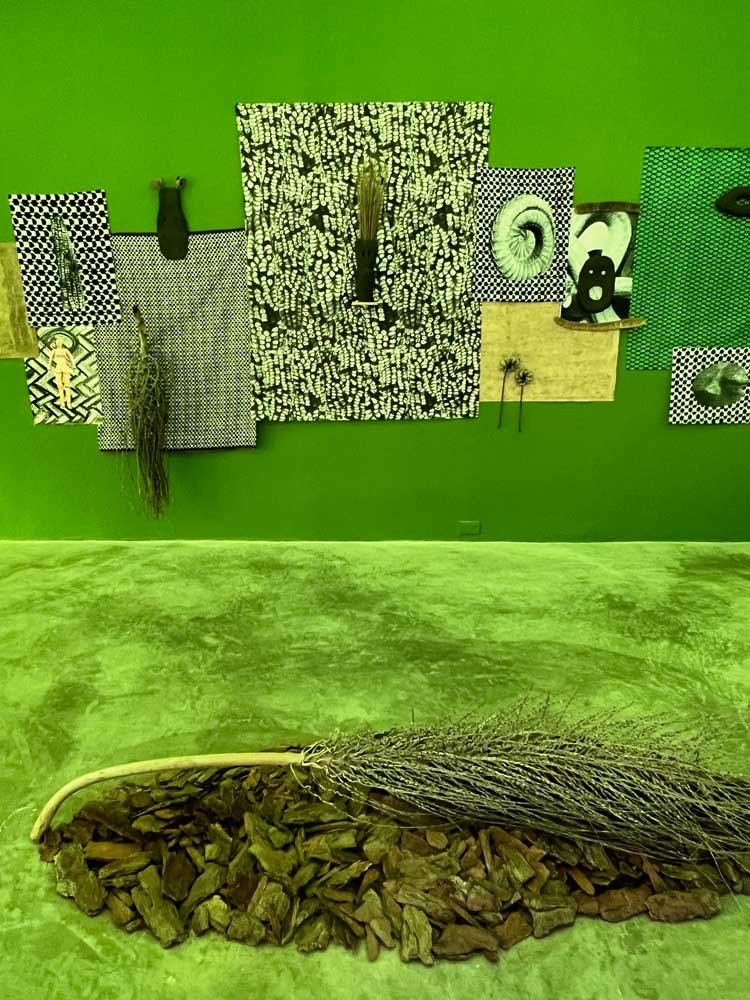
Lucia Pizzani, Morada Vegetal (Vegetal Residence), 2024. Abra, Caracas, courtesy of the artist.
SC: You are incredibly productive, often showing in several spaces at the same time. What do you do to relax?
LP: [laughs] It’s a difficult balance between work and life. A lot of artists I talk to nowadays are going through these kinds of burnouts; in fact, I had one myself a couple of months ago. I am learning to say “no”. In Venezuela, I will finish the installation of my exhibition, and then I’ll do a mix of holiday with two weeks in Margarita Island to work. I really try to plan more, because otherwise you end up damaging your health. As I did.
SC: Did you bring a book?
LP: No! Actually, I don’t read novels that much; I read more scientific kinds of books: about plant reproduction, deep time, botanical remedies. For this trip, I had to bring my entire exhibition [at Abra, Caracas] in my luggage from London, so there was no space for books. Unfortunately, there is not much budget here in Venezuela for exhibitions, but even so the team in the gallery is super-professional and it’s been great working together. The crisis has impacted the arts deeply, but I think it’s very important to continue to exhibit here. I am doing this out of love.
• Lucía Pizzani: Cultivo y Memoria (Crop and Memory) is at Harewood Biennial, Harewood House, Leeds, until 20 October; Rites, Seeds and Refuge is at Cecilia Brunson Projects, London, until 9 August; and Morada Vegetal is at Abra, Caracas, until 8 September. Pizzani will also be part of the curated ceramics section Smoke at Frieze London, from 9 to 13 October.